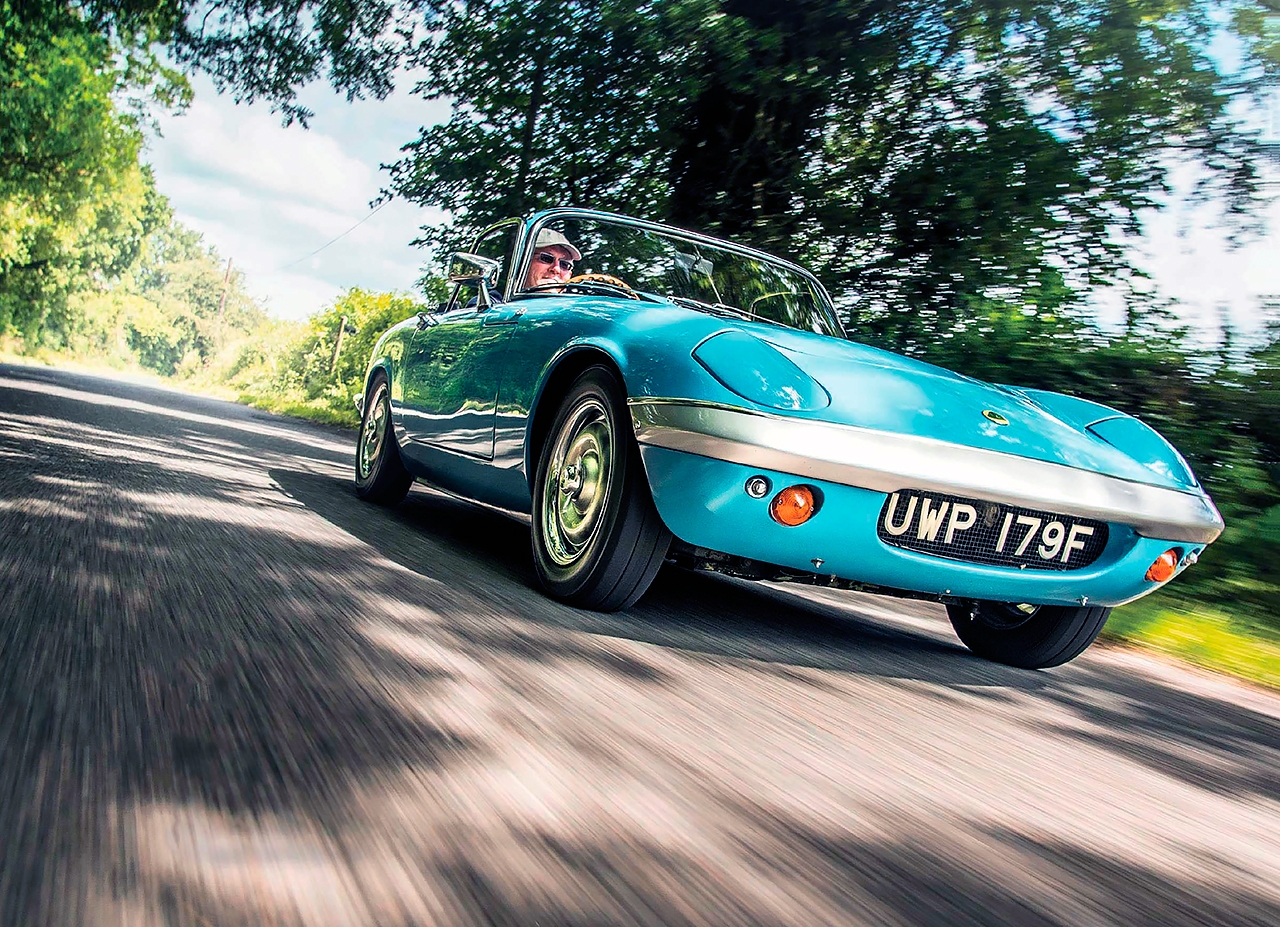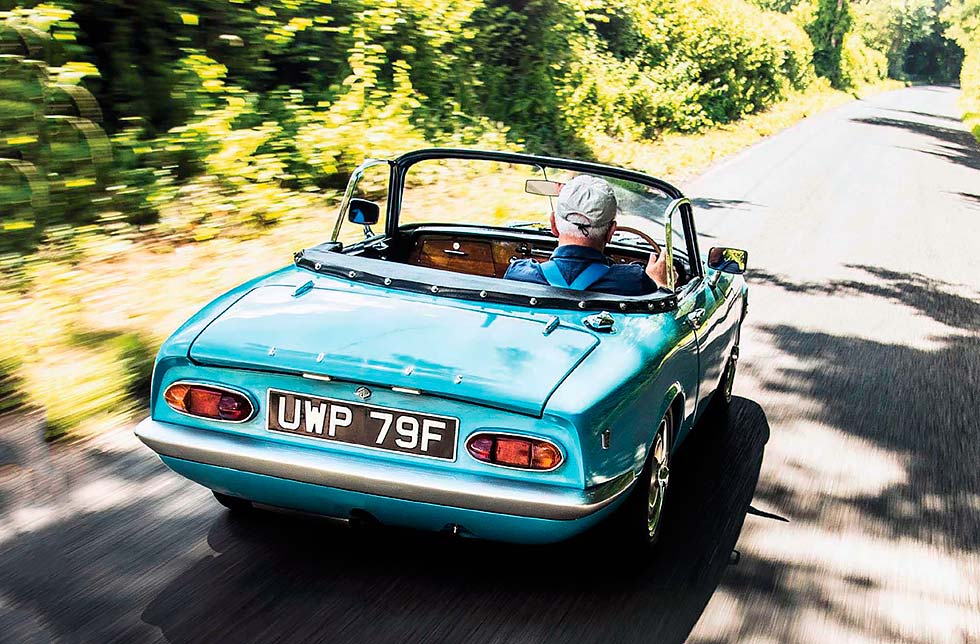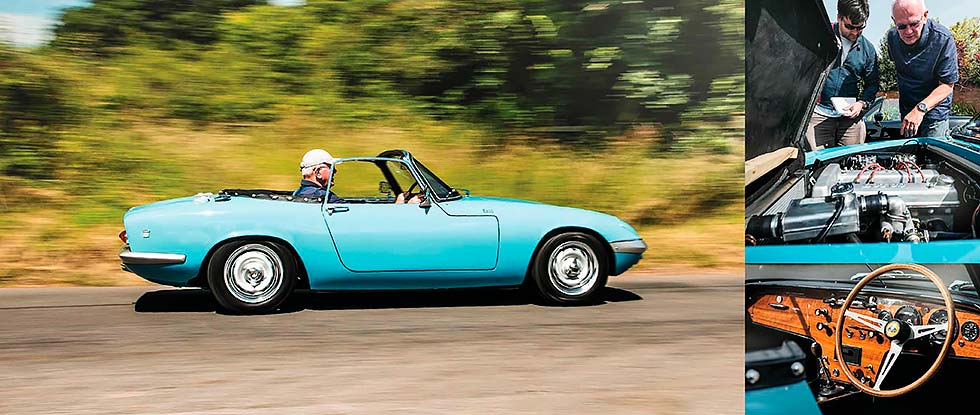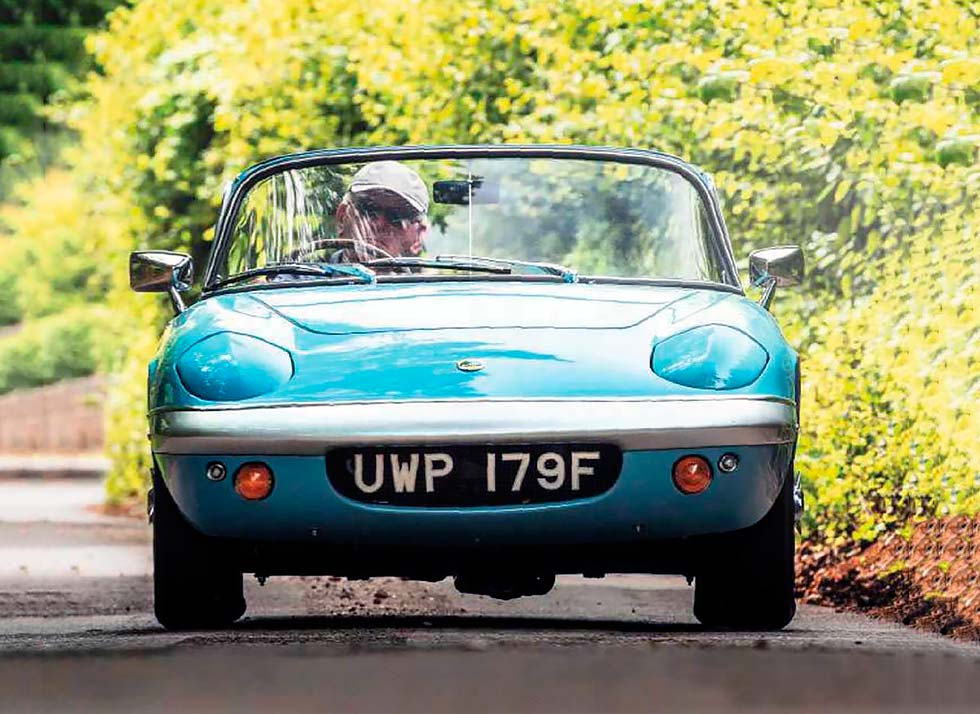
Reader Dave Handley realises his dream of driving a Lotus Elan. ‘I’ve been driving a MkI MX-5 for the past seven years. I love it, but I’d like to see how it compares to Chapman’s finest’. Words Sam Dawson. Photography Jonathan Jacob.
The List
Mini Cooper S MkI ‘Seeing Michael Caine push three of them down a mountain in The Italian Job had a traumatic impact on me while I was saving for my first car’.
Triumph GT6 ‘I owned a Spitfire before my first child was born – I’d like to see how much better they are with six cylinders ’,
Jaguar S-type ‘Robbery and The Sweeney – need I say more?’
Triumph TR8 ‘I’ve owned two TR7s and have happy memories of watching Tony Pond rally a TR8 – but I’ve never driven one.
British sports cars may not always have stood on Dave Handley’s drive but I get the strong impression within moments of meeting him. We’re on the forecourt of Lotus specialist Paul Matty, and I’m about to give him the chance to drive an Elan, something he’s awaited for five decades. ‘I’m a Brummie and all my family were in the motor industry,’ he explains. ‘Dad worked for Pressed Steel in Ludlow as a coachbuilder but it was more than just a job. When I was a kid he always seemed to be in the garden fixing old cars. Sadly, I’ve inherited none of his abilities.
‘Given my background it’s odd that I’d want to drive a Lotus Elan so much – it had a Fordbased engine and we were a BMC family, so to have anything to do with Ford was an act of treason – but I know precisely which three things brought it about. Firstly, BMC used to hold private motor shows for the families and friends of employees in the Sixties and the first two cars I sat behind the wheel of were an Austin-Healey 3000 and an MG Midget and I immediately realised I preferred the smaller car.
‘Secondly, before Scalextric there was a metal racetrack system called VIP and one of the cars in the set that I owned was an Austin- Healey Frogeye Sprite. I didn’t know what it was at the time, but I loved its compactness and rounded shape. But TV was the decider. Drama-wise all you got on the telly in the early Sixties were old American imports, which I found boring.

‘Then suddenly you got all these inventive British series. At the forefront were The Prisoner and The Avengers, both of which had cool lead characters who drove Lotuses – still small British sports cars but compared to Austin-Healeys and MGs they were rare, exotic-looking and much faster. And you’ve managed to find an Elan the same colour as Emma Peel’s!’
Dave can’t resist parking his Mazda MX-5 alongside, but noticing the size difference makes him slightly hesitant to jump into the 267mm shorter Elan simply because he’s 6ft 4in. However, Paul Matty insists that anyone can fit into the car. ‘I was really worried about being able to fit,’ says Dave. ‘In order to drive the MX-5 comfortably I had to fit longer seat runners and remove the central armrest, footrest and sunvisors – and it’s so much bigger than the Elan. But there’s almost too much room in the Lotus – the seat isn’t even on its furthest-back setting.
‘I’ll have to get used to the reclined driving position, but I suppose the cockpit represents Colin Chapman’s thinking, of adding lightness. By removing anything you don’t really need you free up space and make the car more usable.’
Dave turns the ignition key and beams as the 1558cc Lotus-Ford crackles into life, giving the accelerator a few swift prods when stationary to appreciate the engine’s song. ‘Twin Weber 40s – you can recognise that sound anywhere,’ he notes. ‘That’s another thing I love about the Elan – unlike so many Italian supercars it always seemed to have its feet in the real world. It was semi-affordable, just about within reach. I even remember the adverts at the time claiming you could save money by building it as a kit.
‘You needed some skills, but it was true. When I joined BMC you could spot the apprentices whose parents ran dealerships, because they’d have new Mini Coopers while the rest of us had secondhand Austin A35s. But the metallurgists, who got paid more because they were betterqualified and more highly-skilled, had these exotic home-finished cars. One had an Elan, another had a Ginetta G15 that I helped him to build.

‘The same went for the computer programmers. Back in 1972 things were pretty staid at BMC, full of people in three-piece suits. But the people into computers were from a younger generation who dressed like rock stars. Some of them had Elans and it all made me think, “That’s what I want to do,” so I joined the data department. However, once I’d saved up enough to buy myself a secondhand MG Midget I realised I was too tall for it and mentally wrote sports cars out of my life.’
Dave cocks the stiff yet ultra-precise short-travel gearlever into first and guns the Elan down the A38, towards the region that’s spawned such classic hill climb courses as Chateau Impney, Shelsley Walsh and Prescott. He loves the noise, but he’s still holding back despite open roads ahead.
‘It feels so fragile that I’m terrified to touch anything in case it breaks,’ he exclaims. ‘Those Webers still make a lovely snorting noise, though. The steering is much lighter than I thought it would be. I think it’s because I’ve come from power-assisted MX-5 steering, but I was expecting to have to haul on that wheel. It’s funny – I never liked wood-rimmed steering wheels before because I prefer the grip you get from leather, but in this car I finally get it. The combination of lightness and feedback means it all adds to the feel. The ride quality helps too – it’s not jiggly like so many small sports cars. Everything about it helps you to drive the Elan smoothly.
‘I love the torque, dragging you off the line as you pull away. In fact, it’s in this aspect where you can feel its lightness the most because I know that the torque output of this engine is relatively modest. But the way it gathers momentum with so little effort makes you realise how little it has to move.’
Dave’s still not entirely calm about the Elan experience, though. ‘I didn’t think I’d feel so nervous,’ he admits. ‘It’s not just the light touch needed to drive it. Once you’re under way you realise quite how exposed you are and how compact this car is even though there’s loads of room inside it. Side-impact protection is limited to the keys in my pocket…’

To take his mind off the vulnerability Dave focuses instead on other aspects. ‘I’m surprised how much I like the gearchange,’ he notes. ‘Sixties gearchanges were often so heavy and long-winded that it makes you realise how this one was ahead of its time – so short and quick, it almost feels modern.’
Funnily enough, the Elan’s gearchange action was one of the mechanical aspects design agency IAD deliberately emulated when working on the Mazda MX-5. ‘That said, timing the moment to shift into second gear is difficult. It needs precision, but it’s a reminder of how this is a car that you need to learn over time. There’s so much you have to concentrate on in the Elan that other cars gloss over. You have to look out for potholes to avoid upsetting it, for example.’
We’re in hill climb country now, where the counties of Warwickshire, Gloucestershire and Worcestershire intersect beneath hilly faultlines, forcing roads to take increasingly erratic paths around the topography. Away from the thuggery of modern traffic, Dave finally relaxes, matching the car’s rhythms to those of the tarmac. ‘That pop and crackle on the overrun – I like that,’ he notes. ‘Back when we had MG Metro Turbo company cars at Austin-Rover we used to take pipes off the wastegates just to get that sound.’
Dave tackles a series of increasingly tight, undulating bends, not feeling the need to push too hard, revelling in the way the Elan’s exquisite chassis remains so neatly poised and compliant. The gritted, nervous grin he wore at the beginning of the day has now become an expression of pure joy.
‘I absolutely love it,’ he shouts. ‘Admittedly it’s taken a lot of getting used to, but I like that. I like the sense of procedure, almost like pre-flight checks in a light aircraft. The way you have to let the handbrake off before doing up the seatbelt harnesses because you can’t reach it otherwise, the timing of the shift from first to second gear, knowing when to apply the power and hearing the reward of the induction roar.
‘It seems silly that I didn’t mention this earlier – maybe it’s an old memory that’s crept up on me today – but for me a crucial part of this car’s appeal is the fact that Jim Clark drove one, so the way the Elan drives is bound up in motor sport history. I remember Clark’s career but funnily enough the aspects of it that stick in my mind most aren’t the Formula One drives but his wheellifting exploits in the Lotus Cortina and his adverts in car magazines promoting Lotus road cars. Those things are somehow more relevant to driving this car than the F1 cars. When I sit, low and reclined behind that wooden wheel, I really do feel like Jim Clark and I never expected that.
‘But it appeals on a much simpler level than that really,’ Dave adds wistfully. ‘It’s the details – the sun shining off the chrome window surrounds, the dashboard air vents the size of halfpennies, the oval grille with the numberplate characters applied individually… There’s much more about the design that’s decorative and beautiful than first meets the eye. It’s not just about function, aerodynamics and weight-saving – it is a genuinely beautiful car.’
We’ve completed our loop through the countryside and are heading back down the A38 to Paul Matty when Dave recalls a moment from the early days of British Leyland that sums up both the era and the high regard in which the handling mastery of Lotus cars was held. ‘I was working at the Morris division in the late Sixties when we were told that the firm was preparing a new sports saloon, the test mule for which had supposedly been photographed on a test track actually out-cornering a Lotus Elan. We were all told it would be the best car in its class, an absolute world-beater. In the end it turned out to be the Marina TC, so someone was fibbing, but it was a nice thought while it lasted – a family saloon that ran rings around a Lotus Elan.
‘But this is a proper sports car and with the roof off nothing else comes close. I did end up with sports cars through BL’s company car scheme, simply because in the early days of the Triumph TR7 they were selling so badly they had a surplus of them and were eager to give us new ones every six months. But they were comfortable GTs, really – the Elan is probably the finest sports car of its era.
‘I definitely want an Elan now – more than I thought I would. It’s still too fragile to contemplate using daily but as a weekend prospect it’s still my dream car, even taking Ferraris into account. There are aspects of their design that are deliberately showy, making them too flash for my liking. But the Lotus is purely about driving, and that’s what’s most important.’
Dave is so enthused by his Lotus drive that he’s already started planning his ideal Elan. ‘I’d have a Sprint,’ he decides. ‘The standard car is more than fast enough, but the cred of owning that big-valve engine used in the racing cars of the era just makes it perfect for me. I also think the gold bumpers look better than the silver-painted versions. Although mine wouldn’t be in the Gold Leaf livery – the top half would be green, like my old TR7. Back at BL we called that colour “gangrene”, but I don’t care, I think it looks great. It would set off my perfect car nicely.’
Dave loves the Elan so much he’s already planning his own – right down to the colour.
TECHNICAL DATA 1966 Lotus Elan S3
Engine 1558cc, in-line four-cylinder, dohc, two Weber 40 DCOE carburettors
Power and torque 105bhp @ 5500rpm; 108lb ft @ 4000rpm
Transmission Four-speed manual, rear-wheel drive
Steering Rack and pinion
Suspension Front and rear: independent, wishbones, coil springs, telescopic dampers
Brakes Discs front and rear
Weight 688kg (1516lb)
Performance Top speed: 114mph; 0-60mph: 9sec
Fuel consumption 28mpg
Cost new £1387
Values now £14,000-£30,000
To his surprise, Dave fell for the charms of the Elan’s wood-rimmed wheel.
Lotus twin-cam cylinder head plus twin Weber 40 DCOE carburettors add spice to Ford 1558cc engine.
‘In this car I really feel like Jim Clark – and I never expected that’
Dave was really impressed with the Elan’s handling and with Colin Chapman’s ‘add lightness’ philosophy.
The Elan is smaller than 6ft 4in Dave’s MX-5 but he slotted in comfortably. ‘This is a proper sports car and with the roof off nothing else comes close.
THE IMPORTANT MODELS
1962 Lotus Elan 1500
Styled by Ron Hickman, the first Elan features a Harry Mundy-designed twin-cam cylinder head mated to a 1498cc Ford cylinder block. It’s sold either fully built or as a kit to avoid £400 purchase tax.
1963 Lotus Elan 1600/S2
Prompted at least in part by a need for more torque for the US market, a new 1558cc version of the Lotus twin-cam becomes standard in late 1963. Interior trim improvements in November 1964 earn it the S2 tag.
1965 Lotus Elan S3/SE
A more luxurious coupé, the S3, joins the range in September 1965 followed by a 115bhp Special Equipment (SE) package. By June 1966 the addition of electric windows justifies the S3 name on the drophead too.
1968 Lotus Elan S4
Fitting wider wheels and Stromberg carbs in place of Webers brings about the first body changes – flared wheelarches and a bonnet bulge. The Webers make a comeback after ten months, but the flares and bulges remain.
1971 Lotus Elan Sprint
Ultimate Elan has new 126bhp ‘big valve’ evolution of the twin-cam, stronger driveshafts and F1-inspired Gold Leaf-style decals. It’s discontinued in 1973 as Lotus pushes upmarket with the 500-series Elite.





